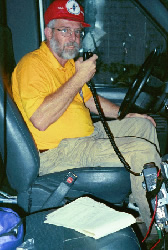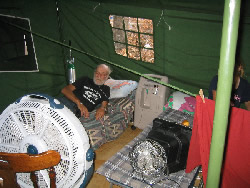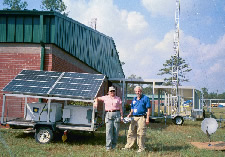Bill Young has found a way to use his knowledge of photovoltaics and HAM radio to help with several disaster relief efforts during the past 17 years. He first worked in hurricane relief efforts after Hugo in 1988, and then his involvement with Brevard County emergency radio services brought him to South Florida to help with Hurricane Andrew relief activities in 1992. Since then, he's been to a few more post-disaster areas and has also taken a number of courses offered by the Red Cross and other organizations on disaster relief. He's now part of a Red Cross damage assessment team that gets called in to help with communication and other needs, and got his share of work last summer with the four hurricanes that hit Florida.
Bill's team goes into an area and determines the need for power, the livability of the area and the communication requirements. His skill as a HAM radio operator lets him set up communications for a wide variety of purposes, from official community needs to letting people contact their family members.
Hurricane Katrina got many FSEC staff members actively involved with hurricane relief projects -- putting together PV equipment and coordinating FSEC's role in a project with both the National Renewable Energy Laboratory and members of the PV industry to get equipment to the Gulf Coast region for use in relief efforts.
Bill spent 10 days helping with emergency communication services. He kept a diary of his efforts to give you an idea of how solar energy was used to help after Hurricane Katrina devastated the Gulf Coast. Here are his words.
Friday, September 16, 2005
 |
| Bill Young operating the communications in Pearlington, Mississippi after Hurricane Katrina using the photovoltaic trailer for power. |
I had received a call previously from the emergency amateur radio operator coordinating the deployment of HAMs to Mississippi. I was asked to team with HAMS from North Carolina. On 9/16, I received confirmation that team assignments were in place, and I was directed to be in Kilm, Mississippi by Sunday. I had already packed up PV disaster equipment and made necessary arrangements to leave. I planned to take the PV disaster trailer made at FSEC, a portable PV system from SunWize, a portable tote from Solar Electric Specialist, a solar radio, my solar cooker and a solar shower. I had also received a call from Larry Kazmerski from NREL, who offered a PV trailer and portable Harvester PV system. He agreed to ship them to me in Kilm.
I arrived at the Florida State Emergency Operation Center in Tallahassee where I met James Montague with State emergency communication. I was given a FEMA tracking number for my assignment to Kilm, where Florida is running the disaster support for Mississippi. I was being deployed to provide emergency communication in Hancock County with other amateur radio operators. I was to join a team from North Carolina. I was advised to take special care when crossing bridges, as some were damaged and others washed out. I was also given hand disinfectant to use, as some people are getting sores from the dirty water.
Saturday, September 17, 2005
 |
PV systems at Point of Distribution in Biloxi, Mississippi.
(Photo: Bill Young) |
On route to Kilm, I stopped in Biloxi and found a distribution center. Faith groups and FEMA were sending supplies to this location and providing people to operate it. Food, water, ice, clothing and other supplies were being distributed at this Point of Distribution (POD). While there, I saw two small PV systems mounted on wheels. Each system had a 75-watt PV module, battery, charge controller and 700-watt inverters. The systems were made by a New York church group that delivered them to several places in Biloxi. The PV systems were used to power fans and lights at the POD.
Around 8 p.m., I started looking for a place to stay. I was told about a Rotary Club (from Plains, N.J.) tent camp and I went there to see if they had power and if I could stay. They had a 10-tent camp with service tables and portable johns. One street over was a city facility that had a generator and lights that lit the tent camp. I spent the night there and used my PV trailer to power my refrigerator in the van.
Sunday, September 18, 2005
I continued on to Kilm. At times, traffic flowed well and other times poorly due to hurricane damage along the road and auto accidents. I arrived at Kilm early afternoon and located the Mississippi/Florida State emergency operations center (EOC) at Hancock County High School, near Stennis Airport. I was given a badge for local identification, received maps and was walked through the operations to learn the setup.
I was given my assignment to Pearlington, Mississippi, 23 miles away. Pearlington is a small town on the western edge of the state at an elevation of about 2 feet. Surge water had reached 10 feet. I met the site manager, volunteer supply manager, food service manager and the communication team. Phil Hoster, KI4IHX, and Kevin McFadden, KD4KWL, of the Cisco team were HAMS providing part time communication. I was assigned to complete the team. A communications team from Cisco Corporation had volunteered to provide emergency communication at this site because they had seen the town on TV and decided to support disaster recovery with their communications equipment. The Cisco team was setting up communication equipment to provide phone and internet service by satellite.
We all helped as needed at this facility, which had a shelter, clinic and distribution center all in one. I returned to Kilm to participate in an 8 p.m. debriefing at the EOC. We checked on requests, problems and welfare issues during the meeting.
Monday, September 19, 2005
At 7 a.m., I returned to my assignment in Pearlington and provided emergency communications and assistance as needed. At lunch time and at the close of the day, we provided a status count of vehicles picking up supplies, pallets of ice, water and food given out during the day. At 7 p.m., I returned to Kilm for the debriefing meeting. I stayed at Kilm at night and returned to Pearlington each morning. While traveling back and forth, I stopped at other shelters or PODs and picked up or delivered items requested or checked on information needed at the EOC.
This was the daily routine, and whenever possible, I would ask if anyone needed a solar generator. At times, I did find someone interested. I pulled the PV trailer behind me everywhere to generate interest and demonstrate its use. I used it for lighting, my refrigerator, fans and HAM radios. I was waiting for the assignment to end to loan the trailer, with the idea that I could go home and return later to retrieve it.
Tuesday, September 20, 2005
Same routine.
Wednesday, September 21, 2005
Cisco was still building their phone and internet communication systems at the shelter and hoped to be done by Friday. They were using an RV for a communication center and had their HAM radios in it. The generator ran all of the time, but today a power cable was over loaded and caught fire. For the rest of the day, HAM communication was run from my solar powered Ham station until repairs could be made.
Thursday, September 22, 2005
Hurricane Rita was coming and the Hancock Emergency Manager ordered volunteer evacuation. The PV trailer from NREL was at Jackson, Mississippi, and the shipper wanted to know where to deliver it. I decided to have it delivered to Hattiesburg, outside the danger area of Rita. I took my PV trailer there and waited out the storm. The Cisco people, the shelter manager, food service workers and others left Pearlington for higher ground.
Friday, September 23, 2005
By noon, there was little danger of Rita hitting us. The evacuation altered intended plans -- I had met several people who were interested in using solar, but were now gone.
Saturday, September 24, 2005
Some workers were returning and being joined by new workers. I was now lining up my PV projects as I had finished my HAM assignment and was able to go home if I wanted to.
A project that did not come together because of Rita was to use the PV trailers at a Boy Scout Camp that was to be used as a tent camp for survivors. There were some successes.
One of my contacts was the driver of a fuel tanker with gasoline and diesel fuel for emergency workers to fuel their vehicles at the EOC. The driver, from Tampa, Florida was using a battery to power the pump to fill vehicles. When the battery needed charging, he would carry the battery to a building with a generator and charge it. I showed him how to use a PV module to charge his battery and we put in a request for a PV module for this use. The module had not arrived by the time I left.
I had met a special-needs person at Pearlington using oxygen by a portable bottle and a power concentrator. Everett Cook, who had emphysema, lived in a tent beside his mobile home destroyed by Katrina. He was waiting for FEMA to supply him with a temporary camping trailer and electricity. A gasoline generator powered his camp site, giving off dirty emissions and needing refueling each day -- requiring him to travel more than 15 miles to get gasoline. I returned from Hattiesburg with the NREL PV trailer and installed it at his camp to provide clean, quite electricity. I will return and get the PV trailer when he is living in his FEMA trailer.
 |
|
 |
Everett Cook was provided clean, quite electricty for his power concentrator.
(Photo: Bill Young) |
|
PV trailer from NREL replaced the noisey gasoline generator that gave off dirty emissions.
(Photo: Bill Young) |
 |
PV trailer powering an emergency radio station in Kilm, Mississippi.
(Photo: Bill Young) |
Sara Allan was a commercial radio announcer originally from a solar-powered radio station in New Mexico, but is now retired in Florida. She came to Hancock to help set up an emergency alert radio station. The radio station, WQRL 103.5 FM in Bay St Louis, was damaged during the storm and was rebuilt with help from FEMA. Now the station announces emergency notices from the Hancock EOC. She was having mechanical generator problems as well as problems keeping the generator refueled. Knowing solar, she was glad to have my PV trailer power the station.
 |
Solar shower used by the medical team at a Pearlington, Mississippi clinic.
(Photo: Bill Young) |
When I got to Pearlington, there were no showers. The medical team in the clinic used solar shower bags to clean themselves each day. There were four stalls and 15 bags for the team to use.
 |
Mike Whithey from North Carolina with his "Ohmsteader" portable photovoltaic systems.
(Photo: Bill Young) |
While at Pearlington, Mike Whithey from North Carolina brought 3 utility work carts with PV systems installed on the carts. The cart had a PV module, battery, charge controller and inverter. He called the system "Ohmsteader".
I found time to use the sun to cook with my solar oven. There were times when the Cisco team was off fixing their communication system leaving me alone. I could not leave the radios, so I used my solar oven to make lunch.
Sunday, September 25, 2005
I spent the morning at the EOC helping with communications and the afternoon checking on the PV systems.
Monday, September 26, 2005
Started for home.
